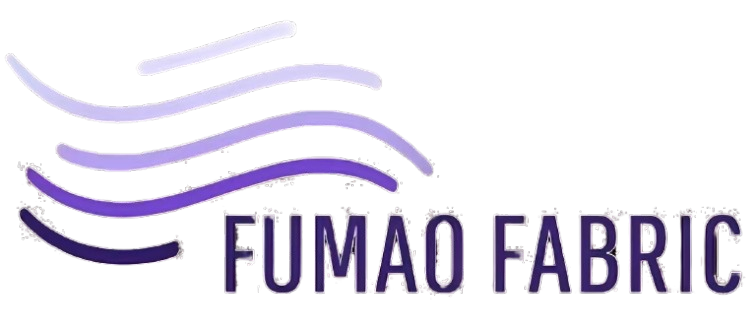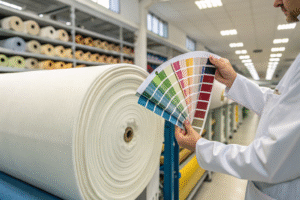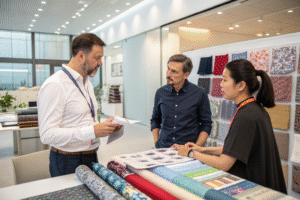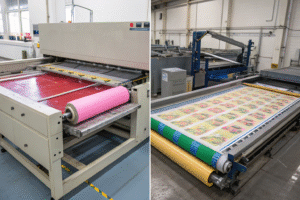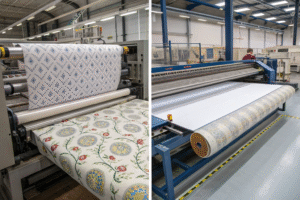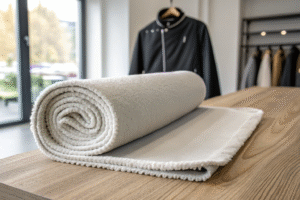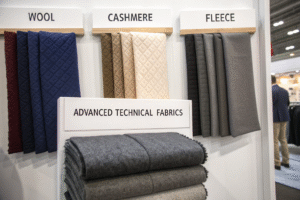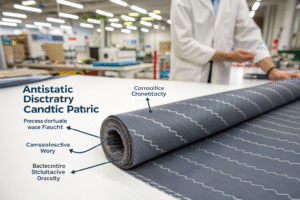Custom woven labels might seem like a small part of garment production—but they carry your brand identity, compliance info, and quality perception. For global buyers managing multiple vendors, sourcing these labels separately from fabric can create unnecessary delays, coordination headaches, and inconsistent branding.
The most efficient way to source custom woven labels is to consolidate them within your fabric orders—through a full-service textile supplier who can offer label customization, sampling, and packaging under one logistics umbrella.
This guide shows how to streamline label sourcing, what to include in your tech pack, and how companies like Fumao Fabric integrate woven label production into their textile workflows for time and cost savings.
Why Bundle Custom Woven Labels with Fabric Orders?
Most apparel makers treat fabric and label sourcing as separate workflows, involving different factories or even countries. But bundling these components in one order unlocks efficiency.
Consolidating custom label sourcing with your fabric order cuts lead time, reduces shipping costs, ensures color coordination, and gives you tighter control over production quality.

How Does It Improve Supply Chain Coordination?
By having both fabric and labels sourced from the same partner, sampling and approval cycles are shortened. PO numbers, logos, Pantone references, and placement guides are unified under one system. Brands like Everlane and Allbirds use integrated sourcing models to ensure brand uniformity across trims.
At Fumao, we tag each woven label roll with the matching fabric lot number, making packing and handoff to garment factories straightforward and mistake-free.
What Cost Savings Can You Expect?
You’ll save on:
- Separate freight charges for trims
- Third-party handling or repacking
- Courier costs for label sampling
Integrated sourcing can cut trim-related logistics costs by up to 30%. Platforms like Apparel Resources report similar trends in consolidated apparel procurement.
What Should Be Included in a Custom Woven Label Order?
A complete woven label order includes far more than just a logo. You’ll need to prepare artwork and tech data to ensure accuracy and branding consistency.
A woven label brief should include size, fold type, color codes, logo artwork, fabric type reference, placement diagrams, and special requirements like anti-fray or iron-safe edges.

What Are the Most Common Woven Label Types?
Here’s a quick overview:
| Label Type | Description |
|---|---|
| Straight Cut | Simple rectangle, raw edge |
| End Fold | Folded on both sides, sewn in seam |
| Center Fold | Folded in the middle, often neck |
| Mitre Fold | Folded diagonally for hem insertion |
| Manhattan Fold | Center fold with hidden end |
See label examples and specs at Dutch Label Shop and LabelWeavers.
How Do We Match Labels to Fabric Construction?
Certain fabrics require heat-sealed edges or ultra-soft threads to avoid irritation or fraying. For example, knitted bamboo garments may use satin-woven labels with ultrasonic edge sealing. Our team adjusts density and yarn twist based on the backing fabric you select. Clients can reference GSM and finish when ordering woven labels to avoid incompatibility.
Which Factories Offer Fabric + Label Sourcing Together?
Integrated textile suppliers are rare but powerful partners. They handle weaving, dyeing, label production, QC, and packing under one system—saving you vendor coordination and customs trouble.
Factories like Fumao Fabric offer fully customized woven label development as part of fabric sourcing projects, giving you control over branding without multiple vendors.

How Do You Identify a Qualified Label-Producing Mill?
Ask these questions:
- Do you use Jacquard shuttle looms or needle looms?
- What’s your minimum order quantity for woven labels?
- Can you match colors to Pantone or fabric dye lot?
- Are your labels certified by OEKO-TEX or REACH?
You can compare full-service textile vendors on Alibaba Verified or Fibre2Fashion.
How Does Fumao Manage Label Orders?
We offer:
- MOQ from 2,000 pcs per design
- Sampling in 4–5 working days
- 100% colorfast, iron-safe, OEKO-TEX yarns
- Custom folding, end-cutting, and adhesive-back options
All woven label cartons are packed with corresponding fabric rolls and marked per PO. This makes life easier for garment factories during final assembly.
What Are Common Pitfalls When Ordering Labels Separately?
Separate label sourcing creates more room for human error, miscommunication, and delays. The further apart the production of fabric and trims, the greater the risk of inconsistency.
Common mistakes include mismatched colors, late trim arrival, MOQ disputes, and missing regulatory elements like fiber content or country-of-origin tagging.

What Label Compliance Rules Should You Consider?
In the U.S., care and content labeling is regulated by the Federal Trade Commission (FTC). EU also requires fiber labeling under Textile Regulation 1007/2011. For garments entering Japan or Canada, bilingual labels may be required.
You can check FTC’s Care Labeling Guide and EU’s Labelling Overview for reference.
How Can Fumao Help Avoid Trim-Related Delays?
We sync your fabric orders with label production, ensuring all trims ship in one batch. Our internal calendar schedules label weaving parallel to fabric finishing. If any deviation in Pantone or font occurs, we flag it during the digital sample approval stage and resolve before bulk is committed.
Conclusion
Custom woven labels carry your brand identity into the hands of every customer—and sourcing them efficiently makes all the difference. By bundling label development with fabric sourcing, you avoid delays, gain consistency, and streamline your supply chain. At Fumao Fabric, we make this easy with in-house label production, digital sampling, and PO-level packing coordination. For sourcing teams who want more control and less hassle, fabric + label integration is the future.
